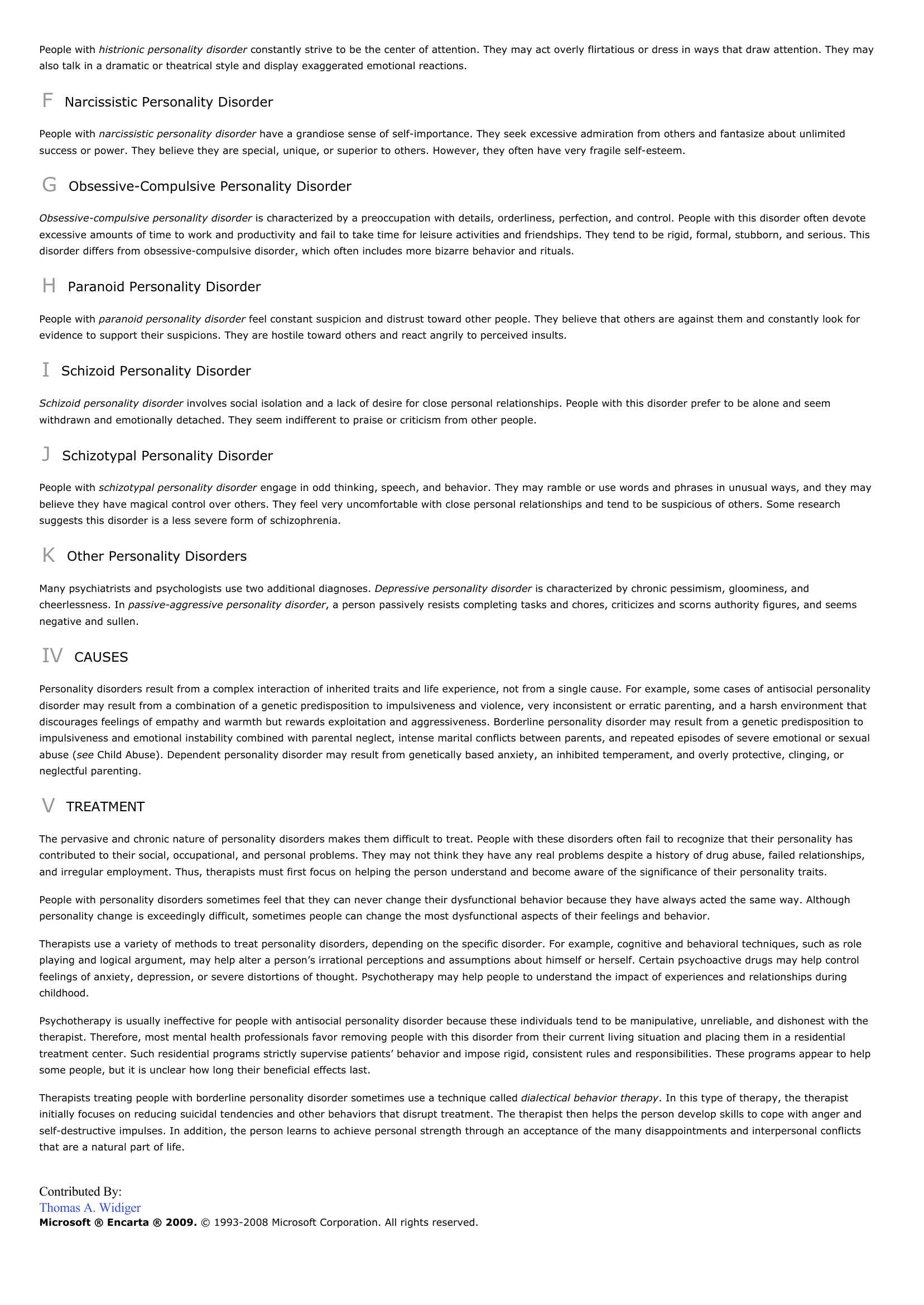Personality Disorders.
Publié le 10/05/2013

Extrait du document
«
People with histrionic personality disorder constantly strive to be the center of attention.
They may act overly flirtatious or dress in ways that draw attention.
They may also talk in a dramatic or theatrical style and display exaggerated emotional reactions.
F Narcissistic Personality Disorder
People with narcissistic personality disorder have a grandiose sense of self-importance.
They seek excessive admiration from others and fantasize about unlimited success or power.
They believe they are special, unique, or superior to others.
However, they often have very fragile self-esteem.
G Obsessive-Compulsive Personality Disorder
Obsessive-compulsive personality disorder is characterized by a preoccupation with details, orderliness, perfection, and control.
People with this disorder often devote excessive amounts of time to work and productivity and fail to take time for leisure activities and friendships.
They tend to be rigid, formal, stubborn, and serious.
Thisdisorder differs from obsessive-compulsive disorder, which often includes more bizarre behavior and rituals.
H Paranoid Personality Disorder
People with paranoid personality disorder feel constant suspicion and distrust toward other people.
They believe that others are against them and constantly look for evidence to support their suspicions.
They are hostile toward others and react angrily to perceived insults.
I Schizoid Personality Disorder
Schizoid personality disorder involves social isolation and a lack of desire for close personal relationships.
People with this disorder prefer to be alone and seem withdrawn and emotionally detached.
They seem indifferent to praise or criticism from other people.
J Schizotypal Personality Disorder
People with schizotypal personality disorder engage in odd thinking, speech, and behavior.
They may ramble or use words and phrases in unusual ways, and they may believe they have magical control over others.
They feel very uncomfortable with close personal relationships and tend to be suspicious of others.
Some researchsuggests this disorder is a less severe form of schizophrenia.
K Other Personality Disorders
Many psychiatrists and psychologists use two additional diagnoses.
Depressive personality disorder is characterized by chronic pessimism, gloominess, and cheerlessness.
In passive-aggressive personality disorder , a person passively resists completing tasks and chores, criticizes and scorns authority figures, and seems negative and sullen.
IV CAUSES
Personality disorders result from a complex interaction of inherited traits and life experience, not from a single cause.
For example, some cases of antisocial personalitydisorder may result from a combination of a genetic predisposition to impulsiveness and violence, very inconsistent or erratic parenting, and a harsh environment thatdiscourages feelings of empathy and warmth but rewards exploitation and aggressiveness.
Borderline personality disorder may result from a genetic predisposition toimpulsiveness and emotional instability combined with parental neglect, intense marital conflicts between parents, and repeated episodes of severe emotional or sexualabuse ( see Child Abuse).
Dependent personality disorder may result from genetically based anxiety, an inhibited temperament, and overly protective, clinging, or neglectful parenting.
V TREATMENT
The pervasive and chronic nature of personality disorders makes them difficult to treat.
People with these disorders often fail to recognize that their personality hascontributed to their social, occupational, and personal problems.
They may not think they have any real problems despite a history of drug abuse, failed relationships,and irregular employment.
Thus, therapists must first focus on helping the person understand and become aware of the significance of their personality traits.
People with personality disorders sometimes feel that they can never change their dysfunctional behavior because they have always acted the same way.
Althoughpersonality change is exceedingly difficult, sometimes people can change the most dysfunctional aspects of their feelings and behavior.
Therapists use a variety of methods to treat personality disorders, depending on the specific disorder.
For example, cognitive and behavioral techniques, such as roleplaying and logical argument, may help alter a person’s irrational perceptions and assumptions about himself or herself.
Certain psychoactive drugs may help controlfeelings of anxiety, depression, or severe distortions of thought.
Psychotherapy may help people to understand the impact of experiences and relationships duringchildhood.
Psychotherapy is usually ineffective for people with antisocial personality disorder because these individuals tend to be manipulative, unreliable, and dishonest with thetherapist.
Therefore, most mental health professionals favor removing people with this disorder from their current living situation and placing them in a residentialtreatment center.
Such residential programs strictly supervise patients’ behavior and impose rigid, consistent rules and responsibilities.
These programs appear to helpsome people, but it is unclear how long their beneficial effects last.
Therapists treating people with borderline personality disorder sometimes use a technique called dialectical behavior therapy .
In this type of therapy, the therapist initially focuses on reducing suicidal tendencies and other behaviors that disrupt treatment.
The therapist then helps the person develop skills to cope with anger andself-destructive impulses.
In addition, the person learns to achieve personal strength through an acceptance of the many disappointments and interpersonal conflictsthat are a natural part of life.
Contributed By:Thomas A.
WidigerMicrosoft ® Encarta ® 2009. © 1993-2008 Microsoft Corporation.
All rights reserved..
»
↓↓↓ APERÇU DU DOCUMENT ↓↓↓
Liens utiles
- Luciano PavarottiIINTRODUCTIONLuciano PavarottiRenowned Italian tenor Luciano Pavarotti was known for his mastery of the highest notes of a tenor's range and for hisjovial personality, which helped him earn a wide popular following.
- Atticus' Personality









